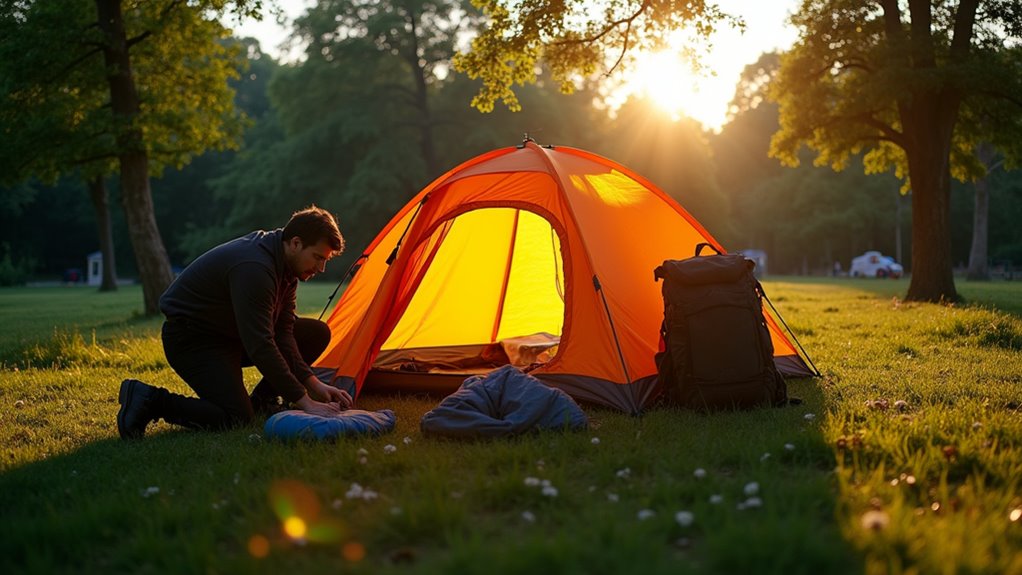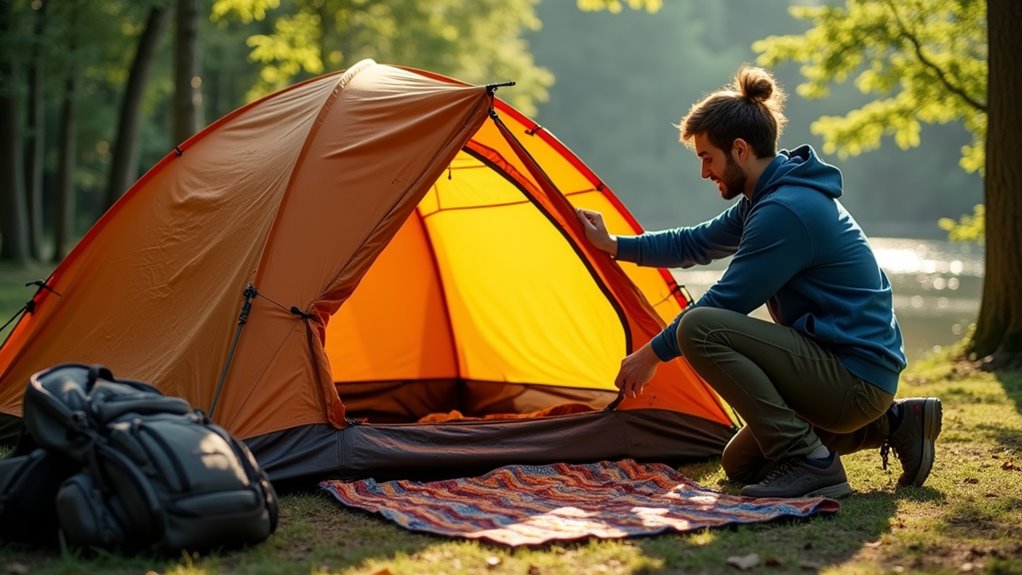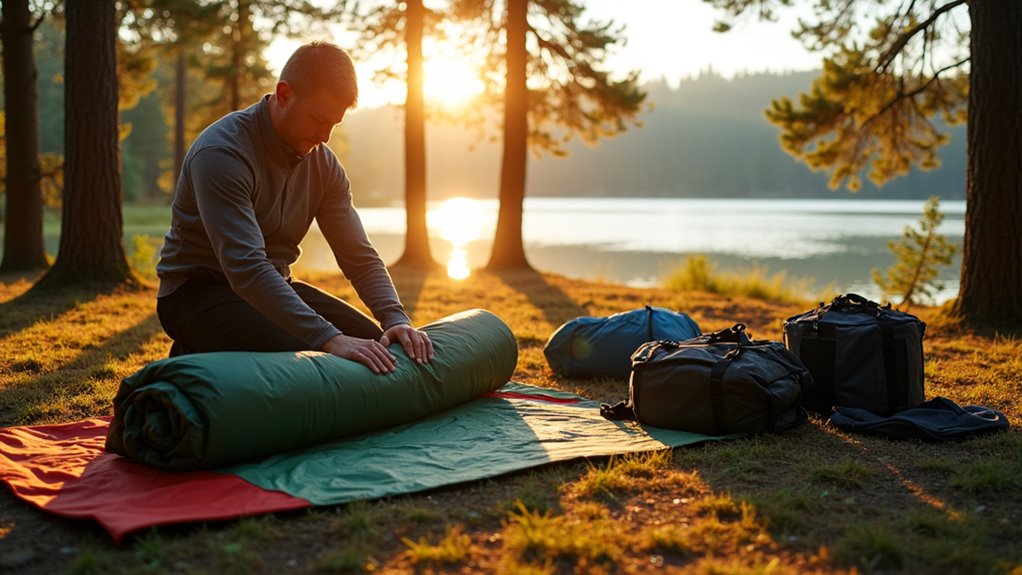How To Fold A Tent
This post contains affiliate links. As an Amazon Associate, we earn from qualifying purchases.
To fold a tent properly, first clean and dry it to prevent mildew, then lay it flat and fold the fabric evenly before rolling it tightly to exclude air. After rolling, pack the rainfly, poles, and pegs in order, and secure everything in a stuff sack for easy storage. Further steps and tips for folding your tent neatly and efficiently are explained in more detail below.
Essential Facts in 30 Seconds
- Ensure the tent is clean and completely dry before folding.
- Remove stakes and poles, then lay the tent flat.
- Smooth wrinkles and align edges to minimize bulk.
- Roll the tent from the thin end, expelling air as you roll.
- Pack the rainfly first, then poles and pegs into the stuff sack.
Preparation Before Folding

Proper tent care starts before folding. Clean the tent well. Use a soft brush or damp cloth to remove dirt, mud, and debris. Avoid strong soaps. They can ruin waterproof coatings. Pay special attention to zippers, seams, and corners. Dirt there can cause problems later. Regularly cleaning the tent helps maintain its longevity.
Check the fabric carefully. Look for tears or damage. Fix small problems before folding. Make sure the tent is fully dry. Wet tents can grow mildew and smell bad. Dry the tent in shade with good airflow to ensure complete drying.
Gather all parts like stakes and poles. Keep them together so nothing goes missing. Spread the tent on a clean surface. Close all zippers to keep dirt out. Smooth out wrinkles. This makes folding easier and the tent smaller. Remember to clean the tent properly before storing it to extend its lifespan.
These steps keep your tent safe and ready for the next trip. Proper care helps it last longer and work better.
Tent Disassembly
Start by pulling out the stakes straight to keep them from bending. removing stakes with a stake puller can save time and effort during disassembly. Next, take off the rainfly from the tent carefully. This way, all parts stay safe and ready for next time. Ensure the tent is unfastened before collapsing to make the process smoother. Handle each piece gently to avoid damage. Keep your tent clean and dry before packing it away. Folding your tent right helps it last longer. Simple steps make packing easy and quick.
Removing Stakes Safely
Removing stakes safely keeps tent takedown easy and accident-free.
Clear the ground around stakes. Remove rocks, sticks, and dirt. Soften hard soil using water or a hammer. Check for wires or pipes under the ground first. Taking care to remove stakes properly helps ensure the tent remains intact during disassembly.
Wear gloves to protect your hands from sharp edges. Stand steady with feet shoulder-width apart. Pull stakes straight up with steady strength. Avoid yanking or twisting.
For strong stakes like rebar, use tools like JackJaw for better grip and power. Secure the tool tightly to avoid slipping. Keep others far away to stop injuries from flying stakes.
Patience works best. Take your time and stay careful for safe removal. Properly removing the stakes also prevents damage to tent fabric tension during disassembly.
Detaching Rainfly Properly
Remove the stakes first.
Then, unhook plastic hooks or buckles holding the rainfly. Focus on the back and side panels.
Next, untie ropes or guy-lines attached to the ground. Loosen webbing straps or buckles at the tent corners.
Undo Velcro tabs that stick the rainfly to poles. Check all toggles and clips are free. Make sure the rainfly is clean and dry to prevent mold or damage during storage conditions.
Slide the rainfly off slowly to avoid damage. Keep the rainfly clean and dry before storage. This helps ensure the rainfly lasts longer and remains effective against weather elements.
Store it in a separate bag or compartment for protection. This helps the rainfly last longer.
Folding the Tent Body

Fold the tent body carefully for a compact result.
Lay the tent flat on the ground.
Remove all stakes and poles to avoid tangling.
Keep the fabric smooth and straight while folding.
Align edges neatly to reduce bulk. This method helps to ensure that you are preparing for packing effectively.
This method makes packing easier and saves space.
A well-folded tent lasts longer and stays clean.
Following these steps every time you pack your tent ensures that the tent remains dry and clean for future use.
Proper Folding Technique
Lay the tent body flat on a clean, dry surface. Take out all stakes, poles, and guylines first. Make sure the tent is dry and clean. Dirt and moisture harm the fabric. Press out any air pockets. Straighten the edges to keep the shape neat.
Fold one side inward toward the center. Match the edges carefully. Fold the other side the same way. This forms a long rectangle. Big tents may need more folds. Don’t stand on the fabric. It can tear or wear out. Keep the fabric smooth and crease-free. This makes packing easier later.
Proper folding helps the tent last longer. Simple steps protect your gear well.
Ensuring Compactness
Compact folding saves space and makes carrying your tent easier.
Lay the tent flat on a clean, dry surface to keep it dry. Press the fabric with your hands to push out air and reduce bulk. Remove stakes and ropes to lighten the load.
Fold one side toward the center, then fold the other side the same way. Use a quarter-fold to make a long, narrow shape. Press the tent again to push out trapped air.
Roll the tent tightly, smoothing the fabric as you roll. Keep steady pressure to avoid wrinkles. This way, your tent fits snugly in its bag for easy transport.
Handling the Tent Fly
Handle the tent fly with care to keep it strong and useful. Make sure the fly is dry to stop mold and mildew. Spread it flat on a clean place. Remove dirt and any small sticks or leaves. Check for holes or loose seams. Fix these before packing. Untie all ropes and take off poles.
Fold the fly lengthwise so it fits the tent poles. Keep the waterproof side inside to protect it. Fold the fly in halves or thirds. Make the folds neat and tight. Fold it widthwise for a small, neat shape. Tuck in any loose ends.
This method helps keep the fly waterproof and ready for your next trip.
Rolling and Packing

Rolling and packing your tent the right way saves time and frustration outdoors.
Fold the tent flat first. Make sure the creases are neat and even. Fold the body and rainfly into three parts. This keeps the tent’s shape strong. Start rolling from the thin part of the fly or the top center. Push out air as you roll. Keep the edges flat for a tight roll.
Pack the parts in order. Put the rainfly down first. Add poles and pegs next. Keep everything neat and easy to find. Roll all parts together and tie them tight. This stops the tent from unrolling.
Put the roll into the stuff sack and close it well. These steps help your tent last longer and make setup fast on your next trip.
Safety and Efficiency Tips
Folding your tent safely saves time and protects your gear.
Clean the tent well. Remove dirt, leaves, and moisture to stop mold and damage.
Follow the instructions from your tent’s maker. This keeps seams and poles strong.
Zip up all zippers and clip all fasteners. This makes packing easy and neat.
Keep tent poles separate. This stops the fabric from getting pierced.
These simple steps help your tent last longer and stay ready for the next trip.
Frequently Asked Questions
How Can I Repair Small Tears in My Tent Fabric?
Small tears in tent fabric repair fast with waterproof patches. Clean the area well and let it dry. Use strong fabric glue or Tenacious Tape for best hold. Press the patch firmly and wait at least 24 hours before use. This method keeps your tent dry and safe. Easy to do, saves money, and extends your tent’s life.
What Should I Do if My Tent Smells Musty?
A musty smell in a tent comes from moisture and mold. Clean the tent by scrubbing spots with mild soap. Use a solution of vinegar and water to kill odors. Soak the tent in an odor remover for strong smells. Let the tent dry completely before packing it away. Keep tents dry to stop musty smells from coming back. Store tents in a cool, dry place for best results. Good care helps your tent smell fresh and last longer.
Can I Fold My Tent When It’s Wet?
Folding a wet tent can cause problems. Wet fabric holds moisture, which leads to mold and bad smells. Always try to dry the tent before packing it away. Leave the tent open in the sun or a dry place. If you must fold it while damp, fold loosely to avoid creases. Once home, dry it fully before storing. Taking these steps helps your tent last longer and stay fresh.
How Often Should I Clean My Tent?
Clean your tent after every camping trip to keep it in good shape. Dirt and moisture can damage the fabric and zippers. For tents used less often, wash thoroughly every 3 to 6 months. This helps prevent mold and keeps the tent strong. Regular cleaning also makes your camping experience better. Simple care extends your tent’s life and saves money. Remember, a clean tent means a happy trip!
What’s the Best Way to Store My Tent Long-Term?
Store your tent dry and clean. Dirt and moisture cause damage and mold. Use gentle soap and water to clean. Let the tent air dry completely before storing. Fold the tent loosely. Tight folds can break fabric and seams. Keep the tent in a cool, dark place. Sunlight and heat weaken materials over time. Check your tent often for tears or holes. Fix small damage quickly to avoid big problems. Proper care can make your tent last many years.
Conclusion
Folding a tent takes care and skill. Following the right steps helps keep it strong and dry. Start by cleaning the tent to remove dirt and moisture. Fold it neatly to avoid wrinkles and tears. Pack it tightly to save space in your bag. Studies show tents last longer when folded properly. Practice makes this task quicker and easier each time. A well-folded tent keeps your gear safe and ready for the next trip. Small effort now means big rewards later.
